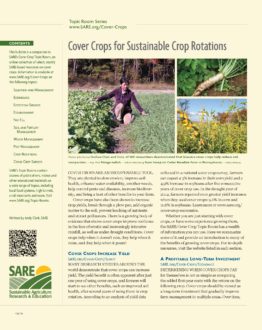Because they improve infiltration and blanket the soil, cover crops have been shown to preserve, not deplete, soil moisture for following cash crops.
The Science of Soil Health: Cover Crops and Moisture
No cropping system is drought proof, but there are things farmers can do to mitigate the effects of a dry year. North Carolina State University's Dr. Chris Reberg-Horton discusses how cover crops affect water dynamics through the life-cycle of the cash crop.
For more information, see the related SARE grant LS12-247, CEFS Long-Term Systems Research: Providing the building blocks of resilient food production systems.

Cultivating Climate Resilience on Farms and Ranches
This bulletin outlines the new challenges that changing weather patterns pose in agriculture throughout the United States, and what you can do to make your farm more resilient. Download File (6.77 MB) | Online Text Version

Dryland Cover Cropping Boosts Yields
Nebraska farmers Keith and Brian Berns found they could use cover crops in dryland farming to increase corn yields, and now are sharing their knowledge.
SARE Cover Crops Webinars
As part of the Missouri SARE State Program, Debi Kelly hosted two webinars on Cover Crops in fall 2012. Presenters included Charles Ellis, a Natural Resource Engineer with the Lincoln County University of Missouri Extension Center, and Rich Hoormann, an Agronomy Specialist with Montgomery County University of Missouri Extension Center.
Also, visit SARE's database for reports on these research projects:
- No-Till Wheat into Medic vs. Conventional Wheat (1999, Montana)
- Winter Cover Crops for Corn Production in the Northeast: N Balance and Soil Moisture Status (1989, Maryland)
Dig deeper into cover crops research: SARE has funded hundreds of research and education projects related to cover crops since 1988. This topic room features only a glimpse into SARE's entire portfolio of cover crop research. To discover more, visit SARE's database of projects and conduct full text or advanced keyword searches.
